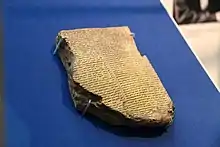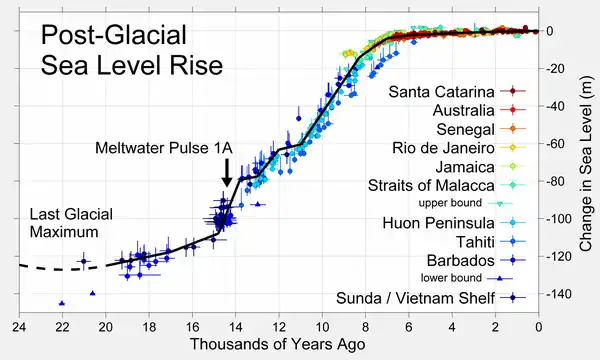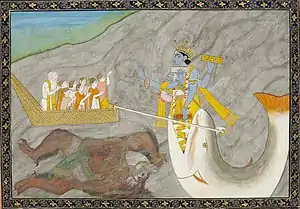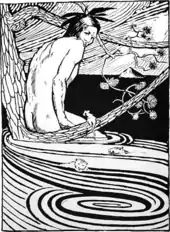Flood myth
A flood myth or deluge myth is a myth in which a great flood, usually sent by a deity or deities, destroys civilization, often in an act of divine retribution. Parallels are often drawn between the flood waters of these myths and the primaeval waters which appear in certain creation myths, as the flood waters are described as a measure for the cleansing of humanity, in preparation for rebirth. Most flood myths also contain a culture hero, who "represents the human craving for life".[1]

The flood-myth motif occurs in many cultures as seen in: the Mesopotamian flood stories, Pralaya in Hinduism, the Gun-Yu in Chinese mythology, Deucalion and Pyrrha in Greek mythology, the Genesis flood narrative, Bergelmir in Norse mythology, the arrival of the first inhabitants of Ireland with Cessair in Irish mythology, in parts of Polynesia such as Hawaii, the lore of the K'iche' and Maya peoples in Mesoamerica, the Lac Courte Oreilles Ojibwa tribe of Native Americans in North America, the Muisca and Cañari Confederation in South America, Africa, and some Aboriginal tribes in Australia.

Mythologies
Although the story of Noah in the Hebrew Bible has become the most well-known flood myth in Western culture, it shows the influence of earlier narratives from Mesopotamia. The nineteenth-century Assyriologist George Smith first translated a Babylonian account of a great flood,[2] and further discoveries produced several versions of the Mesopotamian flood myth; the version closest to that in Genesis appeared in a 700 BC Babylonian copy of the Epic of Gilgamesh.[3] Many scholars believe that this account was copied from the Akkadian Atra-Hasis,[lower-alpha 1] which dates to the 18th century BC.[5][lower-alpha 2] In the Gilgamesh flood myth, the highest god, Enlil, decides to destroy the world with a flood because humans have become too noisy. The god Ea, who had created humans out of clay and divine blood, secretly warns the hero Utnapishtim of the impending flood and gives him detailed instructions for building a boat so that life may survive.[7][8] Both the Epic of Gilgamesh and Atra-Hasis are believed to have originated in the Sumerian creation myth[9]—the oldest surviving example of such a flood-myth narrative, known from tablets found in the ruins of Nippur in the late 1890s and translated by Arno Poebel.[10]

In the Book of Genesis (c. 6th century BC)[11] the god Yahweh, who had created man out of the dust of the ground,[12] decides to flood the earth because of the corrupted state of mankind. Yahweh then gives the protagonist, Noah, instructions to build an ark in order to preserve human and animal life. When the ark is completed, Noah, his family, and representatives of all the animals of the earth are called upon to enter the ark. When the destructive flood begins, all life outside of the ark perishes. After the waters recede, all those aboard the ark disembark and have Yahweh's promise that he will never judge the earth with a flood again. Yahweh causes a rainbow to form as the sign of this promise.[13] Some religious scholars deny the earlier existence of the Gilgamesh narrative, reversing the direction of literary inheritance.[lower-alpha 3]
In Hindu mythology, texts such as the Satapatha Brahmana (dated to around the 6th century BC)[16] and the Puranas contain the story of a great flood, "Pralaya",[17] wherein the Matsya Avatar of the Vishnu warns the first man, Manu, of the impending flood, and also advises him to build a giant boat.[18][19][20] In Zoroastrian Mazdaism, Ahriman tries to destroy the world with a drought, which Mithra ends by shooting an arrow into a rock, from which a flood springs; one man survives in an ark with his cattle.[21]
In Plato's Timaeus, written c. 360 BC, Timaeus describes a flood myth similar to the earlier versions. In it, the Bronze race of humans angers the high god Zeus with their constant warring. Zeus decides to punish humanity with a flood. The Titan Prometheus, who had created humans from clay, tells the secret plan to Deucalion, advising him to build an ark in order to be saved. After nine nights and days, the water starts receding and the ark lands on a mountain.[22]
Like many other folk-tale elements from around the world, the story of flood survival and human re-start (motif A 1021.0.2 and associated elements) appears in Stith Thompson's Motif-Index of Folk-Literature.[23]
Historicity
A worldwide deluge, such as the one described in Genesis, is incompatible with modern scientific understanding of natural history, especially geology and paleontology.[24][25] In an early example of ichnology, Leonardo da Vinci explains in his notebooks that the fossils of marine shells would have been scattered in such a deluge, and not gathered in groups, which were evidently left at various times on mountains in Lombardy; he also doubts that so much water could have evaporated away from the Earth.[26]
Excavations in Iraq have revealed evidence of localized flooding at Shuruppak (modern Tell Fara, Iraq) and various other Sumerian cities. A layer of riverine sediments, radiocarbon dated to about 2900 BC, interrupts the continuity of settlement, extending as far north as the city of Kish, which took over hegemony after the flood. Polychrome pottery from the Jemdet Nasr period (3000–2900 BC) was discovered immediately below the Shuruppak flood stratum. Other sites, such as Ur, Kish, Uruk, Lagash, and Ninevah, all present evidence of flooding. However, this evidence comes from different time periods.[27] The Shuruppak flood seems to have been a localised event caused through the damming of the Karun River through the spread of dunes, flooding into the Tigris, and simultaneous heavy rainfall in the Nineveh region, spilling across into the Euphrates. In Israel, there is no such evidence of a widespread flood.[28] Given the similarities in the Mesopotamian flood story and the Biblical account, it would seem that they have a common origin in the memories of the Shuruppak account.[29] The Sumerian King List reads:
After kingship came down from heaven ... the kingship was taken to Shuruppak. In Shuruppak, Ubara-Tutu became king; he ruled for 5 sars and 1 ner. In 5 cities 8 kings; they ruled for 241,200 years. Then the flood swept over.[30]

Floods in the wake of the last glacial period may have inspired myths that survive to this day.[31] It has been postulated that in North America, flood myths may be based on a sudden rise in sea levels caused by the rapid draining of prehistoric Lake Agassiz at the end of the last Ice Age, about 8,400 years ago.[32]
The geography of the Mesopotamian area was considerably changed by the filling of the Persian Gulf after sea waters rose following the last glacial period. Global sea levels were about 120 m (390 ft) lower around 18,000 BP and rose until 8,000 BP when they reached current levels, which are now an average 40 m (130 ft) above the floor of the Gulf, which was a huge (800 km × 200 km, 500 mi × 120 mi) low-lying and fertile region in Mesopotamia, in which human habitation is thought to have been strong around the Gulf Oasis for 100,000 years. A sudden increase in settlements above the present water level is recorded at around 7,500 BP.[33][34]
Adrienne Mayor promoted the hypothesis that global flood stories were inspired by ancient observations of seashells and fish fossils in inland and mountain areas. The ancient Greeks, Egyptians, and Romans all documented the discovery of such remains in these locations; the Greeks hypothesized that Earth had been covered by water on several occasions, citing the seashells and fish fossils found on mountain tops as evidence of this history.[35]
Another hypothesis is that a meteor or comet crashed into the Indian Ocean around 3000–2800 BC, created the 30-kilometre (19 mi) undersea Burckle Crater, and generated a giant tsunami that flooded coastal lands.[36] Some of the largest tsunamis in history, resulting from the Chicxulub impact, 66 million years ago, were thought to have affected roughly the entire Americas (or nearly all of the Western Hemisphere).[37]
In the late 17th century, there were speculations accounting for the Genesis flood by natural causes. Thomas Burnet’s Telluris Theoria Sacra (Sacred Theory of the Earth) had water rising from the hollow earth. William Whiston's A New Theory of the Earth postulated that major changes in the earth’s history could be attributed to the action of comets.
Speculation regarding the Deucalion myth has also been introduced, whereby a large tsunami in the Mediterranean Sea, caused by the Thera eruption (with an approximate geological date of 1630–1600 BC), is the myth's historical basis. Although the tsunami hit the South Aegean Sea and Crete, it did not affect cities in the mainland of Greece, such as Mycenae, Athens, and Thebes, which continued to prosper, indicating that it had a local rather than a regionwide effect.[38]
A controversial hypothesis of long-term flooding is the Black Sea deluge hypothesis, which argues for a catastrophic deluge about 5600 BC from the Mediterranean Sea into the Black Sea. This has been the subject of considerable discussion.[39][40] The Younger Dryas impact hypothesis is another proposed natural explanation for flood myths, but this idea is similarly controversial.
Art
 18th-century engraving of the great flood
18th-century engraving of the great flood

 The Great Flood, by anonymous painter, The vom Rath bequest, Rijksmuseum
The Great Flood, by anonymous painter, The vom Rath bequest, Rijksmuseum The Deluge, by Francis Danby, 1840. Oil on canvas. Tate Gallery
The Deluge, by Francis Danby, 1840. Oil on canvas. Tate Gallery
See also
References
Footnotes
- The Atra-Hasis flood myth contains some material that the Gilgamesh flood myth does not.[4]
- Andrew R. George points out that the modern version of the Epic of Gilgamesh was compiled by Sîn-lēqi-unninni, who lived sometime between 1300 and 1000 BC.[6]
- Biblical scholar and rabbi Joseph Hertz claims that "The resemblances between this Babylonian story and the Biblical account lie on the surface... [with] a few features common to both: the whole human race is doomed to destruction; one man with his dependants and animals is saved in a ship; the episode of the dove and the raven; and after leaving the ship, the man offers sacrifices and receives Divine blessings." According to Hertz, the differences are more significant, being that "The Babylonian story is unethical and polytheistic ... and lacking in reverence and restraint. ... [Contrarily,] the Hebrew Deluge is a proclamation of the eternal truth that the basis of human society is justice, and that any society which is devoid of justice deserves to perish." Hertz cites Assyriologists who "tell us [that the Babylonian story] seems to have been reduced to writing as early as the days of Abraham,"[14] a descendant of Noah—whose historicity is disputed.[15]
Citations
- Leeming, David (2004). Flood | The Oxford Companion to World Mythology. Oxford University Press. ISBN 9780195156690. Retrieved 17 September 2010.
- "Secrets of Noah's Ark - Transcript". Nova. PBS. 7 October 2015. Retrieved 27 May 2019.
- Cline, Eric H. (2007). From Eden to Exile: Unraveling Mysteries of the Bible. National Geographic. pp. 20–27. ISBN 978-1-4262-0084-7.
- George 2003, p. xxx.
- Tigay, Jeffrey H. (2002) [1982]. The Evolution of the Gilgamesh Epic. Bolchazy-Carducci Publishers. pp. 23, 218, 224, 238. ISBN 9780865165465.
- George 2003, pp. ii, xxiv–v.
- Finkel, Irving. The Ark Before Noah. Doubleday, 2014.
- Pritchard, James B. (ed.), Ancient Near Eastern Texts Relating to the Old Testament (Princeton, NJ: Princeton University Press, 1955, 1969). 1950 1st edition at Google Books. p.44: "...a flood [will sweep] over the cult-centers; to destroy the seed of mankind; is the decision, the word of the assembly [of the gods]."
-
Black, Jeremy A.; Cunningham, Graham; Robson, Eleanor; Zólyomi, Gábor, eds. (2006) [2004]. "The Flood story". The Literature of Ancient Sumer. Oxford: Oxford University Press. p. 212. ISBN 9780199296330. Retrieved 5 February 2021.
The Sumerian story of the universal Flood [...] resembles the longer version preserved in the Babylonian poems Atra-hasis and the Epic of Gilgamesh. It also bears a strong similarity to the biblical account.
- Black, Jeremy, Cunningham, G. Robson, E. Zolyomi, G. The Literature of Ancient Sumer, Oxford University Press, 2004. ISBN 0-19-926311-6
- Davies, G.I (1998). "Introduction to the Pentateuch". In John Barton (ed.). Oxford Bible Commentary. Oxford University Press. ISBN 9780198755005.
- Davidson, Robert (1973). Genesis 1–11. Cambridge University Press. p. 30. ISBN 9780521097604.
- Cotter, David W. (2003). Genesis. Collegeville, MN: Liturgical press. p. 49. ISBN 0814650406.
- Hertz, J. H., ed. (1960) [1937]. The Pentateuch and Haftorahs: Hebrew Text, English Translation and Commentary (2nd ed.). London: Soncino Press. p. 198. ISBN 0-900689-21-8. OCLC 16730346.
- Moore, Megan Bishop; Kelle, Brad E. (2011). Biblical History and Israel's Past. Eerdmans. pp. 18–19. ISBN 978-0-8028-6260-0.
- "Early Indian history: Linguistic and textual parametres." in The Indo-Aryans of Ancient South Asia, edited by G. Erdosy (1995), p. 136
- Startling Similarity between Hindu Flood Legend of Manu and the Biblical Account of Noah.
- Matsya Britannica.com
- Klostermaier, Klaus K. (2007). A Survey of Hinduism. SUNY Press. p. 97. ISBN 978-0-7914-7082-4.
- Sehgal, Sunil (1999). Encyclopaedia of Hinduism: T–Z, Volume 5. Sarup & Sons. p. 401. ISBN 81-7625-064-3.
- Smith, Homer W. (1952). Man and His Gods. New York: Grosset & Dunlap. pp. 128–29.
- Plato's Timaeus. Greek text: http://www.24grammata.com/wp-content/uploads/2011/01/Platon-Timaios.pdf
-
Quoted in:
Lindell, Kristina; Swahn, Jan-Öjvind; Tayanin, Damrong (1988). "The Flood: Three Northern Kammu Versions of the Story of Creation". In Dundes, Alan (ed.). The Flood Myth. Berkeley: University of California Press. p. 279. ISBN 9780520063532. Retrieved 5 February 2021.
A 1021.0.2 [...] Escape from deluge in wooden cask (drum)
- Montgomery, David R. (2012). The Rocks Don't Lie: A Geologist Investigates Noah's Flood. Norton. ISBN 9780393082395.
- Weber, Christopher Gregory (1980). "The Fatal Flaws of Flood Geology". Creation Evolution Journal. 1 (1): 24–37.
- Da Vinci, Leonardo (1971). Taylor, Pamela (ed.). The Notebooks of Leonardo da Vinci. New American Library. pp. 136–38, 142–48.
- Bandstra 2009, p. 62: (Parrot, 1955)
- Bandstra 2009, p. 62.
- Hendel, Ronald S.(1987), "Of Demigods and the Deluge: towards an interpretation of Genesis 6:1-4" (Journal of Biblical Literature, Vol 186 No 1)
- Langdon, S. (1923). The Weld-Blundell Collection, vol. II. Historical Inscriptions, Containing Principally the Chronological Prism, W-B. 444,. [PDF] Oxford University Press. Available at: http://etana.org/sites/default/files/coretexts/20340.pdf [Accessed 22 Sep. 2018].
- "Biblical-Type Floods Are Real, and They're Absolutely Enormous". DiscoverMagazine.com. 2012-08-29. Retrieved 2015-08-18.
- Early Days Among the Cheyanne & Arapahoe Indians by John H. Seger, p. 135 ISBN 0-8061-1533-5
- "Lost Civilization Under Persian Gulf?", Science Daily, December 8, 2010
- Rose, Jeffrey I. (December 2010), "New Light on Human Prehistory in the Arabo-Persian Gulf Oasis", Current Anthropology, 51 (6): 849–883, doi:10.1086/657397, S2CID 144935980
- Mayor, Adrienne (2011). The First Fossil Hunters: Paleontology in Greek and Roman Times: with a new introduction by the author. Princeton: Princeton University Press. ISBN 978-0691058634.
- Carney, Scott (November 7, 2007). "Did a comet cause the great flood?". Discover Magazine. Retrieved 17 September 2010.
- Braun, David Maxwell (4 March 2010). "Asteroid terminated dinosaur era in a matter of days". National Geographic Society (blogs). Retrieved 29 July 2017.
- Castleden, Rodney (2001) "Atlantis Destroyed" (Routledge).
- "'Noah's Flood' Not Rooted in Reality, After All?" National Geographic News, February 6, 2009.
- Sarah Hoyle (November 18, 2007). "Noah's flood kick-started European farming". University of Exeter. Retrieved 17 September 2010.
Sources
| Wikimedia Commons has media related to Deluge (mythology). |
- The Epic of Gilgamesh. Translated by Andrew R. George (reprinted ed.). London: Penguin Books. 2003 [1999]. ISBN 0-14-044919-1.
- Bandstra, Barry L. (2009). Reading the Old Testament: An Introduction to the Hebrew Bible (4th ed.). Belmont, CA: Wadsworth/ Cengage Learning. pp. 59–62. ISBN 978-0495391050.
Further reading
- Flood myth (mythology) at the Encyclopædia Britannica
- Bailey, Lloyd R. Noah, the Person and the Story, University of South Carolina Press, 1989. ISBN 0-87249-637-6
- Best, Robert M. Noah's Ark and the Ziusudra Epic, Sumerian Origins of the Flood Myth, 1999, ISBN 0-9667840-1-4.
- Dundes, Alan (ed.) The Flood Myth, University of California Press, Berkeley, 1988. ISBN 0-520-05973-5 / 0520059735
- Faulkes, Anthony (trans.) Edda (Snorri Sturluson). Everyman's Library, 1987. ISBN 0-460-87616-3.
- Greenway, John (ed.), The Primitive Reader, Folkways, 1965.
- Grey, G. Polynesian Mythology. Whitcombe and Tombs, Christchurch, 1956.
- Lambert, W. G. and Millard, A. R., Atrahasis: The Babylonian Story of the Flood, Eisenbrauns, 1999. ISBN 1-57506-039-6.
- Masse, W. B. "The Archaeology and Anthropology of Quaternary Period Cosmic Impact", in Bobrowsky, P., and Rickman, H. (eds.) Comet/Asteroid Impacts and Human Society: An Interdisciplinary Approach Berlin, Springer Press, 2007. p. 25–70.
- Reed, A. W. Treasury of Maori Folklore A.H. & A.W. Reed, Wellington, 1963.
- Reedy, Anaru (trans.), Nga Korero a Pita Kapiti: The Teachings of Pita Kapiti. Canterbury University Press, Christchurch, 1997.
